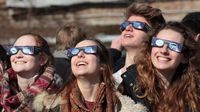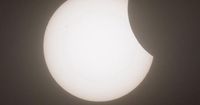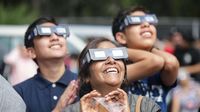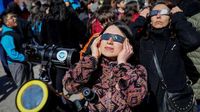On March 29, 2025, a partial solar eclipse will grace the skies across Germany, offering a rare opportunity for stargazers and astronomy enthusiasts alike. This celestial event, where the moon will obscure approximately 15 to 20 percent of the sun's disk, will be visible in various locations, including Karlsruhe and Lüneburg. As excitement builds for this astronomical phenomenon, experts are urging observers to take the necessary precautions to ensure a safe viewing experience.
The partial solar eclipse will begin at different times depending on the location. In Karlsruhe, the eclipse will commence at 11:20 AM, peak at 12:09 PM, and end at 12:58 PM, lasting a total of 1 hour and 37 minutes. Meanwhile, in Lüneburg, the event will kick off around 11:30 AM, reach its apex at approximately 12:15 PM, and conclude shortly after 1 PM, with around 20 percent of the sun covered.
As thrilling as it may be to witness the moon's shadow moving across the sun, experts caution that viewing a solar eclipse without proper eye protection can lead to serious eye damage. The Bundesamt für Strahlenschutz (Federal Office for Radiation Protection) emphasizes that looking directly at the sun can cause irreversible retinal burns. Therefore, it is crucial to use solar eclipse glasses that meet safety standards, allowing only 0.001 percent of sunlight to pass through.
Tim Florian Horn, the director of the Berlin Planetarium, recommends purchasing eclipse glasses from reliable astronomy accessory retailers. He warns against using makeshift alternatives, such as regular sunglasses or welding goggles, as these do not provide adequate protection. "A solar eclipse glasses for 2 or 3 euros is absolutely sufficient and serves its purpose, provided it has the necessary polarizing filter," said a staff member from a local optical shop.
For those who may not have access to solar eclipse glasses, there are several safe methods to observe the eclipse indirectly. One popular technique is to use a pinhole camera, which allows sunlight to pass through a small opening to project an image of the sun onto a surface. This method is not only safe but also educational, making it a great activity for families.
Another creative option involves using a colander or a strainer. By positioning the strainer in sunlight and placing a piece of white paper on the ground beneath it, observers can see multiple images of the sun projected onto the paper. This method, however, also requires caution to ensure that no one looks directly at the sun.
For those in urban areas or those who prefer a guided experience, many observatories and astronomy clubs across Germany will host viewing events on the day of the eclipse. In Munich, for instance, the Bayerische Volkssternwarte and the Deutsches Museum's observatory will provide opportunities for safe viewing. Additionally, the Zeiss-Großplanetarium in Berlin will host a moderated livestream of the event starting at 11:15 AM, along with on-site viewing options.
The last partial solar eclipse visible in Germany occurred on October 25, 2022, while the last total solar eclipse was in 1999, when darkness enveloped parts of the country for nearly two minutes. The next total solar eclipse over Germany is not expected until September 3, 2081, with Karlsruhe set to experience another total eclipse on June 14, 2151. A partial solar eclipse will be visible in Karlsruhe again on August 12, 2026.
As the date approaches, astronomy enthusiasts are encouraged to prepare adequately for the event. Observers should ensure they have the right protective gear, whether it be solar eclipse glasses or materials to create a pinhole camera. The excitement surrounding the eclipse is palpable, and with the right precautions, it can be a memorable and safe experience.
In addition to the solar eclipse, skywatchers can look forward to other celestial events in 2025, including a close encounter between Venus and Jupiter on August 12. Such occurrences remind us of the wonders of the universe and the importance of observing them safely.
As March 29 draws near, many are gearing up to witness this partial solar eclipse, highlighting not only the beauty of our solar system but also the need for responsible observation. With proper precautions in place, the event promises to be an unforgettable spectacle for all.









